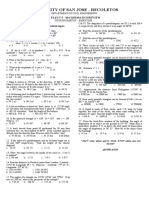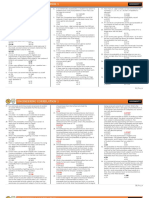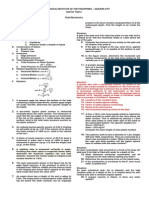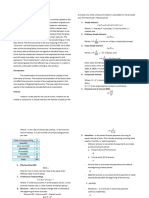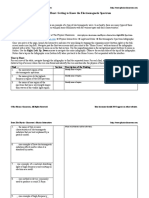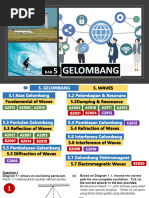0 ratings0% found this document useful (0 votes)
141 viewsMe22 E02 Tumangan M2a1
Me22 E02 Tumangan M2a1
Uploaded by
Jihoo JungThe document contains the solutions to 7 engineering problems related to heat transfer and thermal conductivity. It includes the given values, required quantities, formulas, and calculations for each problem. The name of the student and instructor are provided at the top along with some identifying details for an assessment.
Copyright:
© All Rights Reserved
Available Formats
Download as PDF, TXT or read online from Scribd
Me22 E02 Tumangan M2a1
Me22 E02 Tumangan M2a1
Uploaded by
Jihoo Jung0 ratings0% found this document useful (0 votes)
141 views4 pagesThe document contains the solutions to 7 engineering problems related to heat transfer and thermal conductivity. It includes the given values, required quantities, formulas, and calculations for each problem. The name of the student and instructor are provided at the top along with some identifying details for an assessment.
Original Title
ME22_E02_TUMANGAN_M2A1
Copyright
© © All Rights Reserved
Available Formats
PDF, TXT or read online from Scribd
Share this document
Did you find this document useful?
Is this content inappropriate?
The document contains the solutions to 7 engineering problems related to heat transfer and thermal conductivity. It includes the given values, required quantities, formulas, and calculations for each problem. The name of the student and instructor are provided at the top along with some identifying details for an assessment.
Copyright:
© All Rights Reserved
Available Formats
Download as PDF, TXT or read online from Scribd
Download as pdf or txt
0 ratings0% found this document useful (0 votes)
141 views4 pagesMe22 E02 Tumangan M2a1
Me22 E02 Tumangan M2a1
Uploaded by
Jihoo JungThe document contains the solutions to 7 engineering problems related to heat transfer and thermal conductivity. It includes the given values, required quantities, formulas, and calculations for each problem. The name of the student and instructor are provided at the top along with some identifying details for an assessment.
Copyright:
© All Rights Reserved
Available Formats
Download as PDF, TXT or read online from Scribd
Download as pdf or txt
You are on page 1of 4
ME22/E02
ENGINEERING UTILITIES 2
MODULE #2 ASSESSMENT #1
Name: TUMANGAN, Ma. Estela Leonor Angela P.
Program and Year: CE/3
Student Number: 2019152008
Date of Submission: 9/20/2022
Engr. Marc Allan Magbitang
Name of Instructor
1. Calculate the energy transfer rate across 6 inches wall of
firebrick with a temperature difference across the wall of 50⁰C.
The thermal conductivity of the firebrick is 0.65 BTU/hr·ft·⁰F at the
temperature interest.
Given: ΔT = 50⁰C = 90⁰F; x = 0.6 in = 0.5 ft ; k = 0.65 BTU/hr-ft-F⁰
Required: Energy Transfer Rate
Formula and Solution:
Q/A = [0.65(90)]/0.5 = 117 (3.153) = 368.901 W/m2
2. Calculate the thermal diffusivity of pure aluminum with density
of 2702 kg/m3, thermal conductivity of 237 W/m-K and specific
heat of 0.903 kJ/kg-K.
Given: p = 2702 kg/m3 ; k = 237 W/m-K ; Cp = 0.903 kJ/kg-K
Required: Thermal Diffusity
Formula and Solution:
α = k/p Cp = 237/(2702) (0.903) [0.001/1] = 97.15 x 10-6 m2/s
3. Consider a steam of pipe length L=20 cm, inner radius r=6 cm,
outer radius of 8 cm, and thermal conductivity k=20W/m-K. the
inner and outer surfaces of the pipe are maintained at average
temperatures of T1 =150⁰C and T2 =60⁰C, respectively. Determine the
rate of heat loss from the steam through the pipe.
Given: L = 20cm = 0.2m ; ri = 6cm = 0.06m ; ro = 8cm = 0.08m ;
k = 20W/m-k ; T1=150⁰C = 423.16K ; T2=60⁰C = 333.10K
Required: Rate of Heat Loss
Formula and Solution:
Q = 2πkL[(T1 - T2)/ln (ro/ ri)]
Q = 2π (20) (0.2) [(423.16 – 333.16)/ln (0.08/0.06)]
Q = 7862.67 W
4. A refrigerator stands in a room where the temperature is 20⁰C. The
surface temperature on the outside of the refrigerator is 16⁰C. The
sides are 30 mm thick and have an equivalent thermal conductivity
of 0.1 W/m-K. The heat transfer coefficient on the outside is 10
W/m²-K. Assuming one-dimensional conduction through the sides,
calculate the net heat flow and the surface temperature on the
inside.
Given: x = 30mm = 0.003m ; TR = 20°C ; To = 16.0°C ; K = 0.1 W/m-K ;
h = 10W/m2-K
Required: (a) Net Heat Flow and (b) Surface Temp on the inside
Formula and Solution:
(a) q = h ΔT = (10) / (16 – 20) = –40 W/m2
(b) Tsi = 16 + [(0.03) (–40)]/0.1 = 4°C
5. Solve the critical radius in cm for an asbestos-cement covered
pipe (k=0.208 W/m-K). The external heat transfer coefficient is 1.5
BTU/hr-ft²-⁰F.
Given: k = 0.208 W/m-k ; h = 1.5 BTU/hr-ft-⁰F
Required: Critical Radius 5.675W/m2 ⁰F = 1 BTU/hr-ft²-⁰F
Formula and Solution:
CRA = k/h
0.208/[(1.5) (5.673/1)] = 0.0244m
CRA = 2.44cm
6. A 3-mm diameter and 5-m long electric wire is tightly wrapped
with a 2-mm thick plastic cover whose thermal conductivity is
k=0.15 W/m-⁰C. Electrical measurement indicates that a current of
10A passing through the wire and there is a voltage drop of 8V
along the wire. If the insulated wire is exposed to a medium at 30⁰C,
with the heat transfer coefficient h=12 W/m²-⁰C, determine the
temperature interface of the wire.
Given: k = 0.15 W/m²-⁰C ; I = 10 A ; V = 8 V ; T = 30⁰C ; h = 12 W/m2²-⁰C
L = 5 m ; d = 0.003m
Required: Temperature Interface ; Ti
Formula and Solution:
Q = VI ; Q = (Ti – T)/Rtotal
Ti = Q Rtotal + T
(For Rtotal)
A2 = 2πrL = 2π(0.035) (5) = 0.1099
Rlow = 1/h A2 = 1/(12) (0.1099) = 0.76
Rplastic = ln (r2/r1) / 2πkL = ln (3.5/1.5)/ 2π (0.15) (5) = 0.18
Rtotal = Rlow + Rplastic = 0.76 + 0.18 = 0.9376
Ti = 80 (0.9376) + 30
Ti = 105.01 ⁰C
7. Surface A is coated with white paint and is maintained at
temperature of 200⁰C. It is located directly opposite to surface B
which can be considered a black body and is maintained at
temperature of 800⁰C. What is the total amount of energy
radiated by the black body? Calculate also the amount of heat to
be removed from surface a per unit area to maintain its constant
temperature.
Given: TA = 200⁰C ; TB = 800⁰C ; E = 1 ; σ = 5.67 x 10-8 W/m2 -K4
Required: (a) Energy Radiated and (b) Heat to be Removed
Formula and Solution:
(a) Qradiated
Q = E σ A Ts
Qradiated = (1) (5.67x10-8) (1) (800 + 273.16 K) 4
Qradiated = 75.20 kW
(b) Qremoved
Q = E σ A Ts
Qremoved = (1) (5.67x10-8) (1) [(800 + 273.16) – (200 + 273.16)]
Qremoved = 72.36 kW
You might also like
- Gee 141 Module 2Document12 pagesGee 141 Module 2mojahidrascal269No ratings yet
- Solved Problems in Heat TransferDocument16 pagesSolved Problems in Heat TransferAngelica Joyce Benito100% (5)
- Case AnalysisDocument10 pagesCase AnalysisCLAMONTE JR. MANOLO G.No ratings yet
- 04 - Solving Cashflow ProblemsDocument12 pages04 - Solving Cashflow ProblemsZeeshan AhmadNo ratings yet
- Exchap 02 AnsDocument11 pagesExchap 02 AnsMewnEProwtNo ratings yet
- Eng Econ Im 2 PDFDocument13 pagesEng Econ Im 2 PDFSkyNo ratings yet
- CE Review Advanced MathematicsDocument2 pagesCE Review Advanced MathematicsRAYNo ratings yet
- Plane Trigonometry: Trigonometric IdentitiesDocument2 pagesPlane Trigonometry: Trigonometric IdentitiesJames Darwin SorianoNo ratings yet
- MG1 - L7 - C.7 - PDFedDocument27 pagesMG1 - L7 - C.7 - PDFedBreno PalluNo ratings yet
- Hydraulics: The Science of Hydraulics. Hydraulics Is Defined As That Branch of Science Which Treats ofDocument24 pagesHydraulics: The Science of Hydraulics. Hydraulics Is Defined As That Branch of Science Which Treats ofAj SobremonteNo ratings yet
- Chapter 2 Topic 4 AnnuitiesDocument20 pagesChapter 2 Topic 4 Annuitiesincrediblesmile1234No ratings yet
- P5 3B Gutierrez JohnPaulDocument5 pagesP5 3B Gutierrez JohnPauljp gutierrezNo ratings yet
- Fluid Mechanics Lesson 2Document4 pagesFluid Mechanics Lesson 2PHILIPANTHONY MASILANGNo ratings yet
- 1S1920 - SW - Fluid Mechanics: Name DateDocument12 pages1S1920 - SW - Fluid Mechanics: Name DateBosz' AceNo ratings yet
- Engineering Economy: Lesson 4 - Break Even AnalysisDocument20 pagesEngineering Economy: Lesson 4 - Break Even AnalysisOwene Miles AguinaldoNo ratings yet
- Probset PrelimDocument45 pagesProbset PrelimAndrea MagtutoNo ratings yet
- Geotech1Lab-Laboratory Work No. 2 PDFDocument4 pagesGeotech1Lab-Laboratory Work No. 2 PDFMarc Carlo IbañezNo ratings yet
- Math Samples PDFDocument1 pageMath Samples PDFArwin VillegasNo ratings yet
- Practice Problem No. 1 Hydraulics Fundamentals of Fluid FlowDocument2 pagesPractice Problem No. 1 Hydraulics Fundamentals of Fluid FlowCharlamagne MirandaNo ratings yet
- N 0 T 0 M I M and Iare Taken With Respect To A CentroidalDocument6 pagesN 0 T 0 M I M and Iare Taken With Respect To A CentroidalRetro GamerNo ratings yet
- QUIZ NO.1 Hydrology and Hydraulics Finals Answer KeyDocument2 pagesQUIZ NO.1 Hydrology and Hydraulics Finals Answer KeyJaninay RuideraNo ratings yet
- Chapter5.4 Unsymmetrical BeamsDocument8 pagesChapter5.4 Unsymmetrical BeamsMaryanne Rempillo MarañaNo ratings yet
- Soil MechanicsDocument2 pagesSoil MechanicsJonathan ArcillaNo ratings yet
- Mathematics Mock BoardDocument2 pagesMathematics Mock BoardArabella SanchezNo ratings yet
- Midterm Practice Prob 1Document1 pageMidterm Practice Prob 1Kevin NavidadNo ratings yet
- Littons Problematical RecreationsDocument9 pagesLittons Problematical RecreationsjitlcompanyNo ratings yet
- Enigineering ReviewerDocument5 pagesEnigineering ReviewerWendelyn GarciaNo ratings yet
- Work Pressure and DE Worded For MEDocument3 pagesWork Pressure and DE Worded For MEAngelo Perez DalanginNo ratings yet
- Trigonometry QuestionsDocument45 pagesTrigonometry QuestionsJayvee BustardeNo ratings yet
- Santos ECO Fin HW03Document5 pagesSantos ECO Fin HW03cohenbry1125No ratings yet
- Fluid Flow in Pipes (Continue)Document23 pagesFluid Flow in Pipes (Continue)mark galangNo ratings yet
- 4.1 Effective Stress Concept - CE 304-CE31S8 - Geotechnical Engineering 1Document11 pages4.1 Effective Stress Concept - CE 304-CE31S8 - Geotechnical Engineering 1A ASSDNo ratings yet
- Components of Hydrostatic Force On Curved Surfaces PDFDocument15 pagesComponents of Hydrostatic Force On Curved Surfaces PDFjoseph marimlaNo ratings yet
- Chap 16Document5 pagesChap 16shaito100% (2)
- Completion SurveyingDocument11 pagesCompletion SurveyingPrincess MerryNo ratings yet
- MODULAR QUIZ - 44 - Geotechnical Engineering 4Document8 pagesMODULAR QUIZ - 44 - Geotechnical Engineering 4Cornelio J. FernandezNo ratings yet
- 620PT4032007 2008 2009 2010Document4 pages620PT4032007 2008 2009 2010Mona fabrigarNo ratings yet
- Problem 7. Structural Design "CE Board Exam Nov. 1992Document1 pageProblem 7. Structural Design "CE Board Exam Nov. 1992AlvinNo ratings yet
- Quiz 1 With KTCDocument6 pagesQuiz 1 With KTCacurvz2005100% (1)
- Problem Set 22 Integration, Area, Volume, Surface Area, Length of An Arc, CentroidDocument6 pagesProblem Set 22 Integration, Area, Volume, Surface Area, Length of An Arc, CentroidairaNo ratings yet
- Dynamics Sample ProblemDocument5 pagesDynamics Sample ProblemAljay Dungao40% (5)
- Plate No.2 DynamicsDocument3 pagesPlate No.2 DynamicsEunice CorreaNo ratings yet
- MEEN 20052 - Week 4 - Salamat, Andre Agassi D.Document4 pagesMEEN 20052 - Week 4 - Salamat, Andre Agassi D.andreagassiNo ratings yet
- ES311 ENGINEERING ECONOMICS Module 2nd Sem 2021-2022Document22 pagesES311 ENGINEERING ECONOMICS Module 2nd Sem 2021-2022konoham851No ratings yet
- PART 2 Design Fabrication and Performance Evaluation of Portable Archimedes Screw For Pico Hydro Power Generation in Duangan Balamban CebuDocument24 pagesPART 2 Design Fabrication and Performance Evaluation of Portable Archimedes Screw For Pico Hydro Power Generation in Duangan Balamban CebuRowena Bataluna100% (1)
- Problem 548Document14 pagesProblem 548mike jobernard f. solangonNo ratings yet
- Algebra Take Home Exam 3Document4 pagesAlgebra Take Home Exam 3Jai GicangaoNo ratings yet
- P7 3B Bernardo KathryneDocument4 pagesP7 3B Bernardo KathryneKATHRYNE BERNARDONo ratings yet
- Fluid Mechanics (4th Year)Document2 pagesFluid Mechanics (4th Year)Jaypee Calamba100% (1)
- Referring To The Figure or GraphDocument4 pagesReferring To The Figure or GraphDaniela CaguioaNo ratings yet
- Problem SetDocument2 pagesProblem Setmichael davidNo ratings yet
- Econ Module 05Document13 pagesEcon Module 05derping lemonNo ratings yet
- Final Quiz Problems To Be MadeDocument16 pagesFinal Quiz Problems To Be MadeRyan Reyes100% (1)
- Problem Set 1: Ce123 - HydraulicsDocument1 pageProblem Set 1: Ce123 - HydraulicsZENRIRNo ratings yet
- Ce Integ Fluid Mechanics Not Yet CompleteDocument10 pagesCe Integ Fluid Mechanics Not Yet CompleteRosendo De GuzmanNo ratings yet
- Internal Resistance AppliedDocument11 pagesInternal Resistance AppliedJoshua BacunawaNo ratings yet
- Mechanics of Fluids Problem Set On Total Hydrostatic Force, Dams Ad Buoyancy Identification: Due Date: July 7, 2020Document3 pagesMechanics of Fluids Problem Set On Total Hydrostatic Force, Dams Ad Buoyancy Identification: Due Date: July 7, 2020Mpgmhl C John LyndonNo ratings yet
- Engineering Economics Sample Problem Board 2023Document12 pagesEngineering Economics Sample Problem Board 2023One Piece FanboyNo ratings yet
- Local Media5124777314878222530Document6 pagesLocal Media5124777314878222530Joforce Karl MalanaNo ratings yet
- Hydro 1L Experiment No. 6Document12 pagesHydro 1L Experiment No. 6Auto NomousNo ratings yet
- Res100-11 - E02 - Tumangan - Activity 1Document5 pagesRes100-11 - E02 - Tumangan - Activity 1Jihoo JungNo ratings yet
- Me22 E02 Tumangan M1a2Document4 pagesMe22 E02 Tumangan M1a2Jihoo JungNo ratings yet
- Me22 E02 Tumangan M2a2Document3 pagesMe22 E02 Tumangan M2a2Jihoo JungNo ratings yet
- Me22 E02 Tumangan M1a3Document2 pagesMe22 E02 Tumangan M1a3Jihoo JungNo ratings yet
- Me22 M1a1Document2 pagesMe22 M1a1Jihoo JungNo ratings yet
- Lecture 13Document20 pagesLecture 13MwapeNo ratings yet
- BonacinaDocument8 pagesBonacinaLucas Santos de OliveiraNo ratings yet
- Notes - Temperature Class NotesDocument6 pagesNotes - Temperature Class NotesMohmmad AffanNo ratings yet
- IONE-1B03-SP-PR-0002 PROCESS PROCESS DESCRIPTION For UNIT 03 Rev.0 Code 2 TransmittalDocument10 pagesIONE-1B03-SP-PR-0002 PROCESS PROCESS DESCRIPTION For UNIT 03 Rev.0 Code 2 Transmittalyusuf.yuzuakNo ratings yet
- Huygens' (Wave Optics) 1-22Document39 pagesHuygens' (Wave Optics) 1-22chirayuaggarwal2006No ratings yet
- Adobe Scan Oct 19, 2023Document10 pagesAdobe Scan Oct 19, 2023niladriputatunda1No ratings yet
- 20.huygens Principle and InterferenceDocument9 pages20.huygens Principle and InterferencePUBG - Epic BattlesNo ratings yet
- Scavenger Hunt: Getting To Know The Electromagnetic SpectrumDocument5 pagesScavenger Hunt: Getting To Know The Electromagnetic SpectrumMoonNo ratings yet
- 26 Modern Physics Formula Sheets QuizrrDocument5 pages26 Modern Physics Formula Sheets QuizrrSwapnil SharmaNo ratings yet
- New Copper Cylinder 02Document7 pagesNew Copper Cylinder 02Khalid SaeedNo ratings yet
- GurneyLurey and Heisler SMDocument7 pagesGurneyLurey and Heisler SMMuhammad Nur JumadilNo ratings yet
- Building Physics - 1: Thermal Balance EquationDocument5 pagesBuilding Physics - 1: Thermal Balance EquationNidhi Chadda MalikNo ratings yet
- 02 - Speed and VelocityDocument22 pages02 - Speed and VelocityJhanvi SinghNo ratings yet
- G8 Week 5Document12 pagesG8 Week 5PRIMELYN WAGASNo ratings yet
- Genaral Physics 1Document5 pagesGenaral Physics 1Nicole LagumbayNo ratings yet
- Wavelengths and Frequencies With A Quincke TubeDocument5 pagesWavelengths and Frequencies With A Quincke TubeJose GalvanNo ratings yet
- 200005A - P1 - Flash Point ApparatusDocument11 pages200005A - P1 - Flash Point Apparatusaruthlugnesha2001No ratings yet
- Mechanical Vibrations - VP SinghDocument131 pagesMechanical Vibrations - VP SinghROSHNI MERANINo ratings yet
- Unit 1 Electromagnetic Radiation-1Document23 pagesUnit 1 Electromagnetic Radiation-1Saif YounusNo ratings yet
- Wave WorksheetDocument11 pagesWave WorksheetShigenobu MiñozaNo ratings yet
- Wave Optics NumericalDocument2 pagesWave Optics NumericalABHAY SINGH OFFICIALNo ratings yet
- Heat Transfer Worksheet 2Document2 pagesHeat Transfer Worksheet 2menaga ilangkovanNo ratings yet
- Thermodynamics: Physics SF 016Document39 pagesThermodynamics: Physics SF 016Muhammad SolehinNo ratings yet
- Assignment - Solution 7Document11 pagesAssignment - Solution 7parmodrtkNo ratings yet
- Chapter (7) :: Heat Transfer 1-HeatDocument9 pagesChapter (7) :: Heat Transfer 1-HeatEstiven GierNo ratings yet
- Solid Modeling and Drafting Insem QPDocument2 pagesSolid Modeling and Drafting Insem QPdp9405791781No ratings yet
- Rotational Motion Practice Test AnswersDocument2 pagesRotational Motion Practice Test AnswersAshtherielle CraigeNo ratings yet
- 5 SPM T4 GelombangDocument121 pages5 SPM T4 GelombangNureen ZuhairahNo ratings yet
- KIET PhysicsDocument82 pagesKIET Physicsap cpianNo ratings yet
- CH - 1 To 15 Upm All SolutionsDocument67 pagesCH - 1 To 15 Upm All SolutionsPratik PandaNo ratings yet
























